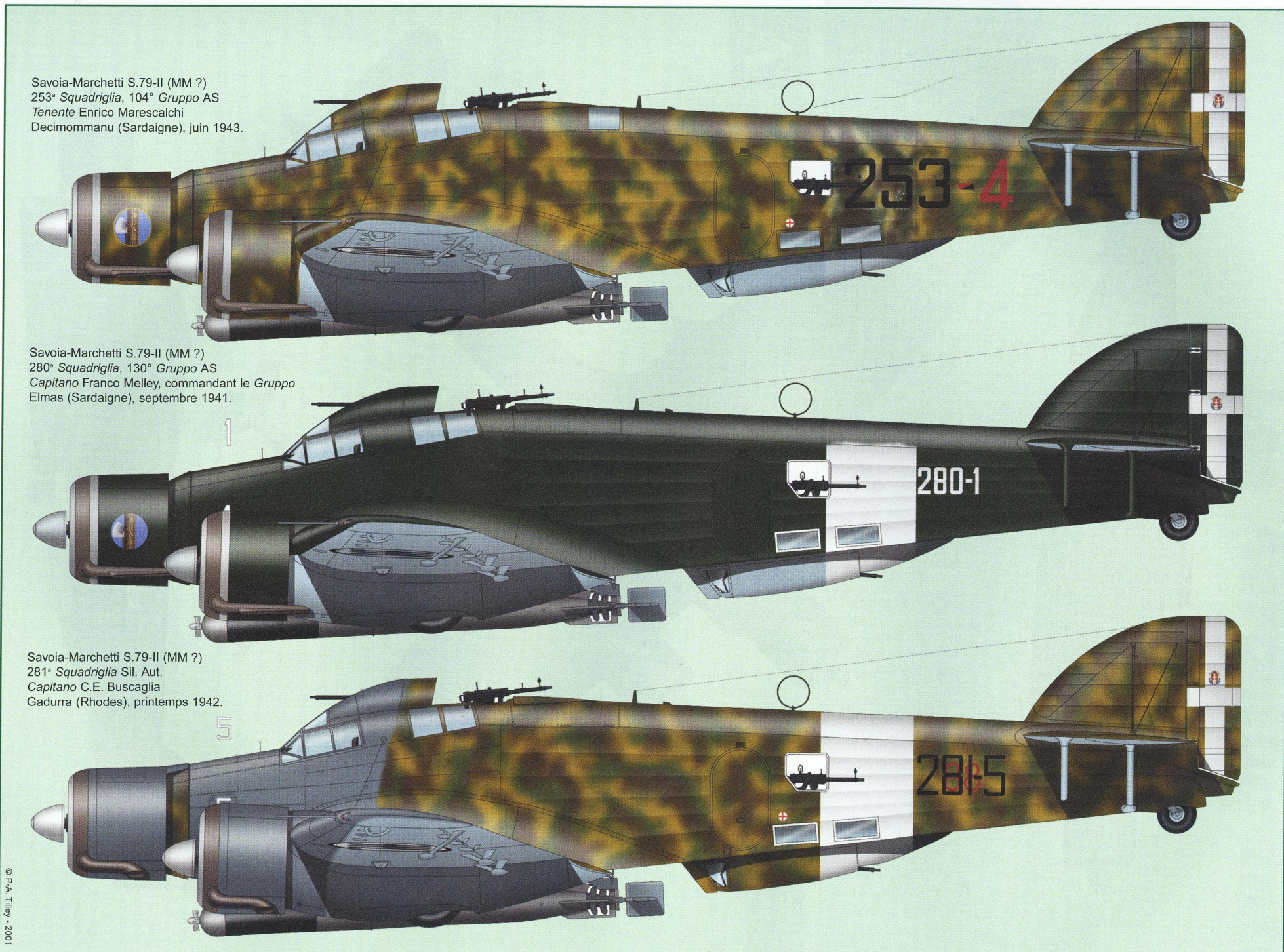
The SM.79 Sparviero (“Sparrow Hawk”) bombers were
constructed of a welded tubular steel frame, covered with duralumin forward,
duralumin and plywood over the top, and fabric elsewhere. The wings were made
of wood. They first saw service with the Aviazione Legionaria units serving in the
Spanish Civil War, where over 100 of these bombers assisted Francisco Franco’s
Nationalist forces mainly in Catalonia. By the time Italy entered WW2, Sm.79
bombers were the backbone of the Italian bomber force. They were used in
France, Greece, Yugoslavia, Crete, Malta, Gibraltar, Palestine, and North
Africa. They were responsible for sinking 86 Allied ships totaling 708,000
tons. After the Italian surrender, 34 SM.79 bombers served with the pro-Allies
government and 36 served with the pro-Axis government in the north.
In 1939, 45 SM.79 bombers were sold to Yugoslavia. Most of
them were destroyed during the German invasion in 1941, but a few survived to
serve in the pro-Axis government after the invasion. Four of them were
evacuated to Britain and were used by the Royal Air Force under the
designations AX702, AX703, AX704, and AX705.
Between 1936 and 1945, 1,350 SM.79 bombers were built. After
the war, a few of them continued to serve with the new Italian air force
Aeronautica Militare as passenger transports; they were retired in 1952. A few
of them made their way to the Lebanese air force and served until 1959.
Squadriglie 252,253
Stormo 46
This Gruppo formed on 15 February 1940 with 15 SM 79
bombers. In June they made bombing raids on Corsica, escorted by G 50s of 51
Stormo, and on 21 June nine SM 79s bombed Marseilles naval port.
The unit adopted several camouflage finishes, from banded to
mottled in the same squadriglia, as new colour orders filtered through from H.
Q. In November they transferred to the Balkans for operations over Greece and
Yugoslavia. To save weight the bombers reduced their defensive weapons from
four to two, despite several combats with RAF Gladiators. The winter produced
heavy snows which reduced the number of operations, but some bombing was still
undertaken. Escorting G 50s joined in with ground strafing.
On 1 May 1942 the unit became Aerosilurante and the more
experienced crews were sent to Sardinia in June for operations against the
HARPOON convoy. On 14 June four aircraft out of twelve were lost, with Medaglia
d’Oro being posthumously awarded to Tenente Ingrellini and Sergente Maggiore
Compiani. On 3 July the whole Gruppo went to the Aegean to operate against
shipping in the eastern Mediterranean. They made armed reconnaissance sorties
as far as Haifa, Port Said, and Port Alexander. On 1 September they became
Autonomo, often co-operating with Fliegerkorps X on convoy attacks and
reconnaissance missions.
By 1 January 1943 they had 8 operational aircraft at
Gadurra, on day and night reconnaissance missions along the eastern and central
African coastlines. On 15 February two SM 79s were intercepted by P-39s between
Tobruk and Mersa Matruh, claiming one fighter shot down. By 20 March six
aircraft were still operational out of thirteen.
From January to March crews were transferred between Kalamaki
and Gadurra for night training by instructors from 1 and 3 NAS. Despite the
setting up at the start of the war of a Blind Flying School (La Scuola di Volo
Senza Visibilta) most new pilots had very little experience of instrument or
night flying as they were rushed to the front with minimal training.
Pilots briefly trained on the Junkers Ju 88 for dive and
torpedo bomber operations, using Luftwaffe aircraft based at Athene. The
practical difficulties of acquiring and supporting such a unit precluded
further pursuit of this role, despite the initial success with training.
In April 1943 one squadriglia sometimes used Coo and
Scarpanto as forward bases. Two aircraft used Timpaklion, Crete, for armed
reconnaissance flights between Appollonia and Benghasi. There were very few
aircraft operational by mid-May, but morale was high with the recent successful
missions which had followed a long wait. On 23 May three SM 79s escorted two
unarmed SM 75s from Gadurra to bomb Gura base in Africa at night. 253 Sq was
detached to Iraklion on Crete, from 25 June to 16 July. By 9 July the unit had
only five out of eleven aircraft serviceable at Gadurra.
In July the Gruppo moved to Italy for re-equipment. They
then carried out night attacks against the invasion fleet off Sicily. 253 Sq
claimed an enemy night fighter off the Ioinian coast on the night of 18 July.
On 7 September eight aircraft were still operational. The two squadriglie
commanders took off at 19.30 hours on 8 September to attack ships in the Gulf
of Salerno. It was not until they were nearing the target area that the
radiomen heard the order for all bomber and fighter units to cancel operations
and return to base. They only turned back when a direct order to all torpedo
bomber units was received from the H. Q. of Squadra 3, landing at Guidonia and
returning to Siena the next day.